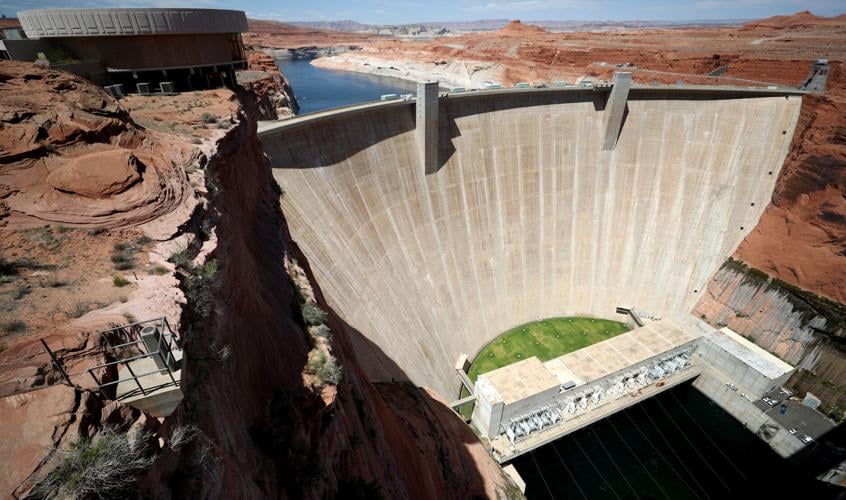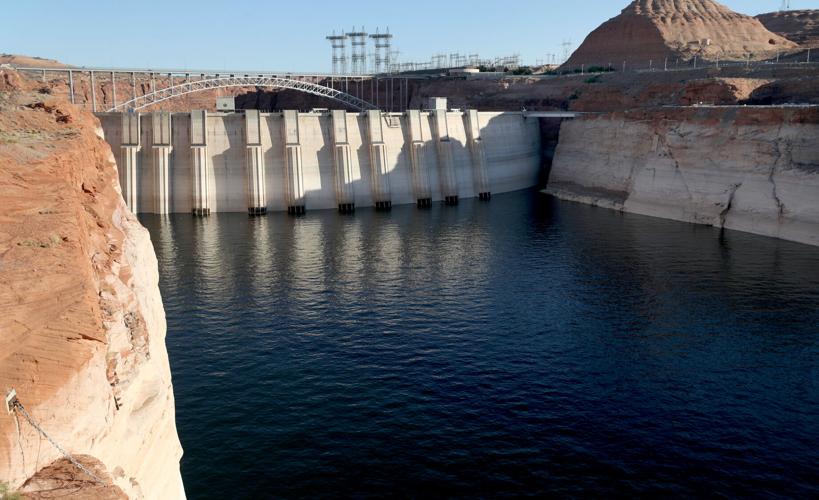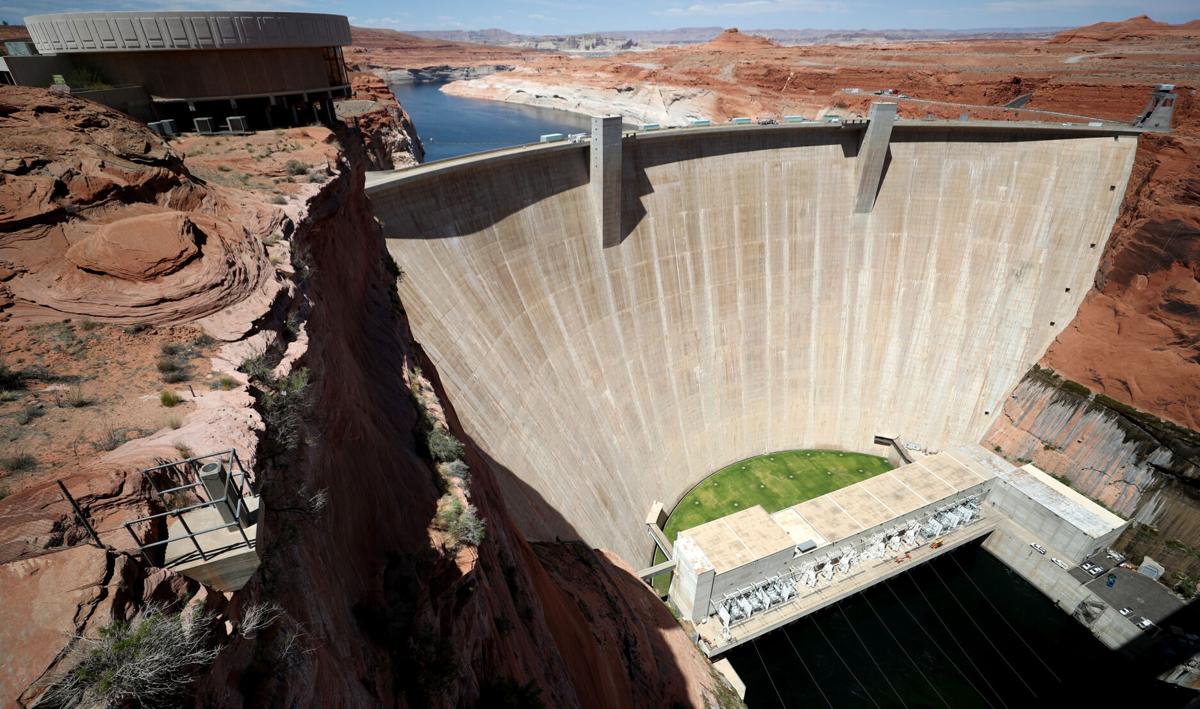Arizona water officials are concerned that a series of important steel tubes buried well underneath Glen Canyon Dam were damaged from an experiment in releasing extra water and sediment through the dam to restore long-eroded beaches in the Grand Canyon.
The reason for the concern is that what’s known as the dam’s outlet tubes may someday have to carry all water through the dam into the Grand Canyon and beyond to Lake Mead, should Lake Powell’s levels fall low enough. At such low levels, the water couldn’t run through the dam’s turbines that generate electricity.
Instead, it would have to pass through the outlet tubes to be delivered to Arizona, California and Nevada in the river’s Lower Basin for drinking and irrigating crops. But if the tubes are too damaged to be used much, water flows through the dam downstream may be limited or non-existent.
The experimental high release of water occurred a year ago, but it appears Arizona officials only learned of the damage to the tubes less than two months ago. If it turns out the outlet tubes aren’t in good enough condition to carry water meant to go through them, that could reduce or eliminate vital water deliveries to those three Lower Basin states, a longstanding Colorado River expert told the Arizona Daily Star.
“It’s a big deal. The bureau has said they intend to use outlet tubes to pass water (when the reservoir is low enough) to meet requirements” under the Colorado River Compact to deliver a minimum specified amount of water downstream to the Lower Basin, said David Wegner, a retired bureau engineer.
“If those tubes were to be compromised, it would seriously restrict the ability of the bureau to send deliveries downstream,” said Wegner.
Information about damage to the dam’s outlet tubes was publicly disclosed last month by Central Arizona Project General Manager Brenda Burman at a meeting of various water interest groups in Phoenix. Burman was commissioner of the Bureau of Reclamation during the Trump administration.
“We received some difficult news from the Bureau of Reclamation about three weeks ago,” Burman told a committee that’s advising Arizona on how to proceed with negotiations over future cuts in Colorado River water use.
Burman said the bureau informed state officials that when federal officials inspected these tubes following the experiments, “they found thinning in the pipes, cavitation and sedimentation problems” at the tubes’ lower end where water is released.
“So they have unknown issues about how these river outlet works would perform. That’s very difficult new information to hear,” Burman told the Arizona Reconsultation Committee on March 6.
‘It’s critical that they work’
The center line of the tubes lies about 185 feet underneath the reservoir’s current water level and nearly 100 feet below the intakes for the dam’s power generators.

The exposed penstocks (intakes to the power turbines) on Glen Canyon Dam near Page, Arizona. When this photo was taken in 2022, the water level was at its lowest since 1967, when the dam was still being initially filled.
There are four — half as many as there are penstocks, which carry water directly into the dam’s turbines when the lake is high enough. The tubes are also significantly smaller than the penstocks — 8 feet in diameter compared to 20 feet, Burman said.
Concerns have been raised for several years about whether these tubes could hold enough water if the lake dropped so low that water could no longer pass through the turbines and generate electricity.
“You can see already by capacity they are limited. What we heard three weeks ago (raises) serious questions from recent work Reclamation has done, about how much water could pass through the outlet works, and not just based on capacity,” Burman said.
Wegner, who remains active in water issues as a private citizen, told the Star, “They absolutely need the four hollow jet tubes and valves. It’s absolutely critical that they have the capacity to use them.
“It’s critical that they work. Otherwise you couldn’t get water through the dam. If it it drops too low that they can’t use the hydropower and if tubes aren’t available, you’re not moving any water,” said Wegner, who today sits on the National Academy of Sciences’ Water, Science and Technology Board.
Cavitation occurs when bubbles get into a liquid, and becomes a problem when it is associated with flowing water, he said. The problem is that the air bubbles in the moving water implode and create shock waves that travel through the liquid and damage equipment. The result is erosion, Wegner said..
“Sediment moving in water has a lot of capacity to erode. If it’s highly concentrated, I would suspect thinning of the pipes would be caused by erosion of sediment,” he said. “The only thing that would erode a pipe is something in the water, and that something is sediment.
“The issue is, as you get lower in the reservoir, the cavitation risk increases. You are entraining more sediment. The risk gets higher as the reservoir gets lower. It’s counter-intuitive, but that’s how it is,” Wegner said.
For the past two weeks, the Star has sought comment from the bureau on the outlet tubes’ condition, the causes damages, and the timing and cost of repairs. A spokeswoman, Becki Bryant, had said the bureau would respond for Wednesday or Thursday.
Instead, on Wednesday afternoon, another bureau spokeswoman, Jenny Erickson, told the Star the bureau would discuss what it calls the “river outlet works” at a webinar Monday to which other media and other interested parties have been invited. “The webinar will answer a lot of your questions,” Erickson said.
In an email Friday afternoon, the bureau said: “Although our latest projections do not show Lake Powell reaching critical elevations within the next 24 months, Reclamation has been proactively investigating Glen Canyon Dam’s abilities to operate at low reservoir elevations because of the possibility of future reservoir declines.
“As information from our enhanced inspections and analyses has come available, Reclamation has begun to share it with the basin states, tribes and other internal stakeholders. We will release a technical memorandum and host a webinar April 8, 2024, to share this information with a wider audience,” the bureau’s statement said.
Many questions, including costs
Another unanswered question about this matter is why the tubes got damaged in 2023 when very similar experimental flows have been released from the dam nine times since 1996. Also, it’s not publicly known what repairs the bureau will perform on the tubes or what they’ll cost.
When the tubes are in good condition, they can carry the water required to be sent to the Lower Basin states and Mexico — nearly 8.3 million acre-feet a year — even when Lake Powell falls as low as 3,440 feet elevation. That’s 50 feet below the minimum level at which the dam’s turbines can generate power.
At about 3,420 feet at Powell, the reservoir would be unable to carry even the 7.5 million acre-feet a year that just the three Lower Basin states have the right to take from the river. At 3,370 feet — commonly called “dead pool” — no water could flow through the dam.
As Lake Powell stands today, those levels are a long way off. On April 4th, Powell was at about 3,559 feet, nearly 70 feet above the lowest point at which the dam can generate power.
But that’s because last year, the Colorado River Basin enjoyed extraordinarily high snowpack and runoff into Powell. This year’s snowpack has been reasonably good and runoff is expected to be only slightly below average, at 89% of normal, says the federal Colorado River Basin Forecast Center.
But in early spring 2022 and 2023, the lake stood at barely above 3,520 feet, or 30 feet above “minimum power pool” elevation. Those low levels were triggered by three years of extreme drought conditions.
Such conditions have been generally the rule since 2000 due to drought and climate change. Many scientists who have studied the river’s conditions say they expect the lower flows to persist or worsen in the coming decades.
Not designed for long-term use
After Glen Canyon Dam’s construction was finished in the mid-1960s, the Bureau of Reclamation wrote a report about its design and construction that said the outlet tubes would “provide for releases for downstream commitments when the power plant is not in operation, and during the period of final closure of the diversion tunnels.”
By “downstream commitments,” the report clearly meant the legal commitments of the four Upper Basin states — Colorado, New Mexico, Utah and Wyoming — to deliver legally specified amounts of water to the Lower Basin states.
“The outlets will also be used to maximum capacity during maximum flood releases,” the report said.
But today, it’s generally agreed by most water experts that Glen Canyon Dam outlets were never intended to be used for routine water deliveries or continuous use, as might be needed if Lake Powell falls low enough for an extended period.

A small fishing boat ties up on the breakwater just outside the intakes for Glen Canyon Dam. At the time of this 2022 photo, the penstocks (water intakes to the power turbines) were being revealed for the first time since 1967 when Lake Powell was being filled.
The 1960s report said, “The outlet works consist of four, 96-inch diameter steel pipes with cast-iron, bellmouth intakes, hollow-jet valves for regulation, and ring-follower gates for emergency closure.”
“A bulkhead gate, which operates under balanced head, is provided at the upstream face of the dam to provide access for servicing the ring-follower gates. A reinforced concrete trashrack structure with structural steel bars protects the entrance.”
But recently, author Eric Kuhn, a retired general manager for a Northern Colorado water district, said, “The flow limitations of the outlet tubes have been known since the dam was designed. It should not be a surprise for anyone.”
Officials knew 69 years ago when the tubes went in that they weren’t designed for long-term use — bureau officials “want to run every drop through the power plant. That makes money. The tubes don’t,” Wegner said.
The tubes have two intakes on the dam’s upstream face, and are controlled at the upper end by a series of gates located 50 feet inside the dam. The tubes’ release of water is controlled by hollow jet valves.
The outlet tubes and valves were tested and brought into operational compliance beginning in January 1963. They’re tested annually to insure they’re functional.
Their first continuous use came during a major flood in the river in June 1983.
Runoff into Powell exceeded the reservoir’s storage space. The tubes were used for months to evacuate water because the dam’s spillways couldn’t be used after a major attack of cavitation eroded concrete from them. The tubes were used again during another period of high flows in 1984, recalled Wegner, who worked for the bureau at the time.
The tubes were used starting in March 1996 for the first of the nine high-flow experiments for the Grand Canyon. Their purpose has been to carry extra sediment to restore Grand Canyon beaches that eroded away because Glen Canyon Dam trapped much of the river’s sediment.
The extra water added velocity and volume to move additional amounts of sediment, said Wegner and retired Utah State University Prof. Jack Schmidt, who both helped design the first high-flow project in 1996.
These experiments, hailed as a boon to the Grand Canyon, were halted after 2018 due to low water in the river but one was done last year when water levels rose. It put 820,000 tons of sediment into the Grand Canyon at a spot 30 miles below Lee’s Ferry, just downstream of the dam, the U.S. Geological Survey said.
But, “each of these events likely impacted the steel river outlet tubes, due to sediment, cavitation, and general wear and tear,” said Wegner, who was program manager for Glen Canyon environmental studies from 1983 through 1996.
Schmidt, retired director of Utah State’s Center for Colorado River Studies, said he has no idea why the tubes are now in questionable condition.
“Perhaps things just wear out,” he said.
Once reservoir elevations drop again, a higher probability exists that more sediment will be entrained into the river water as it flows through the outlet tubes, Wegner said.
Plus, as more air is drawn into the tubes, more cavitation will occur, he said, adding: “Combining air, sediment, and water traveling at high speeds and high volumes creates cavitation.
“There is a basic problem with the design of Glen Canyon Dam — it is not designed to be a run-of-river dam. Therefore it was not designed to operate efficiently and safely at low reservoir conditions,” Wegner said.
‘It’s the money’
At the March 6 meeting of the state water committee, ex-bureau commissioner Burman said of her former employer, “This is an engineering agency who is known for being able to come up with engineering solutions to engineering problems.
“We very much expect to work with Reclamation in the coming months, to investigate exactly what can be done” to fix the tubes’ problems, Burman said.
Committee member Sandra Fabritz said that while the bureau’s engineering is great, “It’s the money Reclamation will need to assess and (find what) one would hope will ameliorate the problem. That’s critical. It’s something for us to think about a concerted effort to collectively talk to our (congressional) delegation about.”
Arizona Department of Water Resources Director Tom Bushchatzke told the committee that Reclamation “has told us they are working on contracts at least” for redoing the outlet tubes’ lining to address their problems by the end of 2024.
“We are concerned because they told us that two years ago. That hasn’t happened. Their bandwidth is being challenged, just like ours. ... I’m not sure how they deal with cavitation and sedimentation. One thing we will talk to Reclamation about is that we want to make sure that they’ve explored all the options for engineering fixes.”
Few options, all daunting
Wegner said his understanding from talking to federal officials is that the bureau will recoat the tubes’ interiors with epoxy to strengthen them. It’s one of a very few options the agency has, he said, including:
— Re-engineer the dam.
— Move river water around the dam when at low elevations by routing it through bypass tunnels at either end — a very expensive proposition.
— Remove the dam.
— Reduce river water use to minimize the possibility the tubes will be used much.
Recoating the tubes is the cheapest solution, and maybe enhancers can be installed so epoxy won’t erode as fast, “but it is still going to erode,” Wegner said. “My concern is sediment coming against the tubes and blocking them.”
More worrisome are the valves at the tubes’ end — “just pieces of metal that open and close. If they closed, you couldn’t move water through them. If they stayed opened, you couldn’t stop water,” he said.
“As an engineer, I will tell you there’s always a solution. The question is the cost, the ability to do it, and the risk of doing it,” Wegner said.
Longtime Arizona Daily Star reporter Tony Davis explains what "dead pool" means as water levels shrink along the Colorado River.







